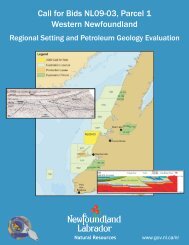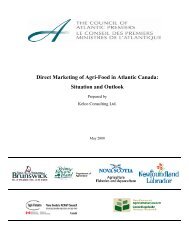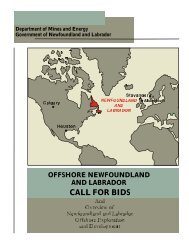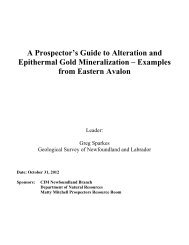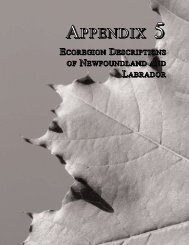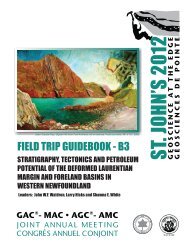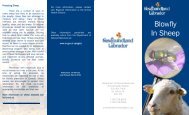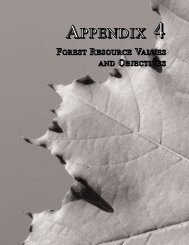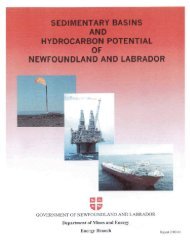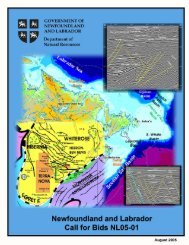Correcting stem deformities in juvenile planted white spruce
Correcting stem deformities in juvenile planted white spruce
Correcting stem deformities in juvenile planted white spruce
You also want an ePaper? Increase the reach of your titles
YUMPU automatically turns print PDFs into web optimized ePapers that Google loves.
wmcwmmME<br />
"IB —iJ.<br />
SILVICULTURE AND RESEARCH SECTION, NEWFOUNDLAND FOREST SERVICE<br />
P.O. BOX 2006, CORNER BROOK, NEWFOUNDLAND, A2H 6J8<br />
_ ; No. 56, February, 2001<br />
FOREST RENEWAL /FOREST IMPROVEMENT NURSERIES TREE IMPROVEMENT MISC.<br />
CORRECTING STEM DEFECTS IN<br />
JUVENILE PLANTED WHITE SPRUCE:<br />
SECOND YEAR RESULTS<br />
by<br />
Basil English, Research Silviculturist<br />
r<br />
"AND IN CONCLUSION..."<br />
• Birds, <strong>in</strong>sects, frost, etc., frequentlydamage the<br />
term<strong>in</strong>al leaders and buds of <strong>juvenile</strong> <strong>white</strong><br />
<strong>spruce</strong>. As a result, multileader<strong>in</strong>g and fork<strong>in</strong>g<br />
are common <strong>in</strong> young plantations of this<br />
species. The question was asked: is thereany<br />
benefit <strong>in</strong> <strong>in</strong>terven<strong>in</strong>g to correct these defects?<br />
• In 1998, a trial was established to assess the<br />
responseof <strong>juvenile</strong><strong>planted</strong> <strong>white</strong><strong>spruce</strong>with<br />
<strong>stem</strong> defects, to form correction. The trial was<br />
assessed <strong>in</strong> the fall of 2000, after two grow<strong>in</strong>g<br />
seasons.<br />
• Prelim<strong>in</strong>ary results<strong>in</strong>dicate that<strong>in</strong>terventionto<br />
correct multileader<strong>in</strong>g and/or<strong>stem</strong> fork<strong>in</strong>g had<br />
a positive impact. For both defect types, the<br />
corrected trees were much more likely to be<br />
well formed after two years than the<br />
uncorrected trees.<br />
• Trees with multiple leaders had a far higher<br />
rate of natural recovery to well formed status<br />
than those with forks: 47% of the former<br />
recovered without <strong>in</strong>tervention ascompared to<br />
only 20% of the latter.<br />
• After two years, almost a third of the control<br />
trees (i.e., trees that were well formed at the<br />
start of the trial) had developed defects. As<br />
well, approximately the same proportion of<br />
deformed/corrected trees had developed new<br />
defects. This pattern, coupled with the<br />
relatively high rate of natural recovery,<br />
suggests that <strong>in</strong>tervention to correct <strong>stem</strong><br />
defects is likely not worthwhile <strong>in</strong> <strong>planted</strong><br />
<strong>white</strong> <strong>spruce</strong>.<br />
INTRODUCTION<br />
Defects, such as muItileaders and forks, are<br />
very common <strong>in</strong> young <strong>white</strong> <strong>spruce</strong><br />
plantations <strong>in</strong> Newfoundland. Such<br />
problems typically arise follow<strong>in</strong>g the loss<br />
of the term<strong>in</strong>al leader or bud to a damage<br />
agent such as frost, <strong>in</strong>sects, birds,<br />
mammals, etc. It has been suggested that<br />
plantation ma<strong>in</strong>tenance activities (e.g.,<br />
clean<strong>in</strong>g out of <strong>in</strong>growth) could be<br />
expanded to <strong>in</strong>clude the correction of such<br />
defects. The question is, would such an<br />
<strong>in</strong>tervention have any last<strong>in</strong>g benefit?<br />
Would the affected trees outgrow the<br />
problem without <strong>in</strong>tervention? Is there any<br />
guarantee that a new defect would not<br />
develop once the exist<strong>in</strong>g one was<br />
NEWFOUNDLAND FOREST SERVICE
corrected? Would those trees that are<br />
currently free of defects rema<strong>in</strong> well<br />
formed <strong>in</strong>to the future?<br />
In the fall of 1998 a trial was set up to<br />
determ<strong>in</strong>e whether or not there is anyth<strong>in</strong>g<br />
to be ga<strong>in</strong>ed by manually correct<strong>in</strong>g<br />
multileader<strong>in</strong>g and fork<strong>in</strong>gdefects <strong>in</strong> young<br />
<strong>planted</strong> <strong>white</strong> <strong>spruce</strong>. The follow<strong>in</strong>g is a<br />
status report on the defect correction trial,<br />
two years post establishment.<br />
METHODS<br />
Forthe purposes of this trial, multileader<strong>in</strong>g<br />
refers to a situation <strong>in</strong> which the tree's<br />
current leader or bud is miss<strong>in</strong>g, dead or<br />
damaged, and two or more lateral shoots<br />
are compet<strong>in</strong>g for crown dom<strong>in</strong>ance.<br />
Fork<strong>in</strong>g refers to a situation <strong>in</strong> which<br />
multileader<strong>in</strong>g last year, or <strong>in</strong> some<br />
previous year, has resulted <strong>in</strong> the<br />
development of two separate and<br />
compet<strong>in</strong>g tops. Generally, multileader<strong>in</strong>g<br />
gives rise to fork<strong>in</strong>g. In this study, trees that<br />
fork at or below ground level are not<br />
considered to be forked.<br />
The trial was <strong>in</strong>corporated <strong>in</strong>to two small<br />
plantations, both of them active research<br />
trials be<strong>in</strong>g ma<strong>in</strong>ta<strong>in</strong>ed and monitored by<br />
the Silviculture and Research Section of the<br />
Newfoundland Forest Service. The first trial<br />
site is located on Corner Brook Pulp and<br />
Paper Ltd. (CBPPL) licensed land at Bottom<br />
Brook <strong>in</strong> Forest Management District (FMD)<br />
14, approximately 25 km due east of<br />
Stephenville. This plant<strong>in</strong>g trial was<br />
established <strong>in</strong> the spr<strong>in</strong>g of 1993 with 67-<br />
multipot conta<strong>in</strong>er and 2 + 2 bareroot <strong>white</strong><br />
<strong>spruce</strong> seedl<strong>in</strong>gs. The objective was to<br />
<strong>in</strong>vestigate seedl<strong>in</strong>g growth response to<br />
various plant<strong>in</strong>g technique/site preparation<br />
options. In the fall of 2000 the plantation<br />
was eight years old.<br />
The second trial site is located on CBPPL<br />
licensed land at South Branch <strong>in</strong> FMD 14,<br />
approximately 6 km northeast of the<br />
community of Coal Brook. This plant<strong>in</strong>g<br />
trial was established <strong>in</strong> the spr<strong>in</strong>g of 1992<br />
to assess the response of 67-multipot<br />
conta<strong>in</strong>er <strong>white</strong> <strong>spruce</strong> to various root<br />
sy<strong>stem</strong> management regimes. In the fall of<br />
2000 this plantation was n<strong>in</strong>e years old.<br />
At each site, assessors flagged all forked<br />
and multileadered trees. Half the trees of<br />
each defect type were corrected with<br />
prun<strong>in</strong>g shears. That is, shears were used to<br />
remove all but the strongest leader (<strong>in</strong> the<br />
case of multileadered trees) or all but the<br />
strongest top (<strong>in</strong> the case of forked trees).<br />
The rema<strong>in</strong><strong>in</strong>g trees were left uncorrected.<br />
Additionally, naturally well formed trees<br />
were selected as controls. As described <strong>in</strong><br />
Table 1, this resulted <strong>in</strong> the creation of five<br />
<strong>stem</strong> form categories. Every attempt was<br />
made to balance the selections so that the<br />
trees <strong>in</strong> each of the five form classes came<br />
from comparable situations. In total, 538<br />
trees are represented <strong>in</strong> the trial.<br />
The heights of all sample trees were<br />
measured at the time of trial establishment.<br />
and aga<strong>in</strong> <strong>in</strong> the fall of 2000. As well,<br />
dur<strong>in</strong>g the fall 2000 assessment, the <strong>stem</strong><br />
form<br />
status of each tree was evaluated.<br />
NEWFOUNDLAND FOREST SERVICE




